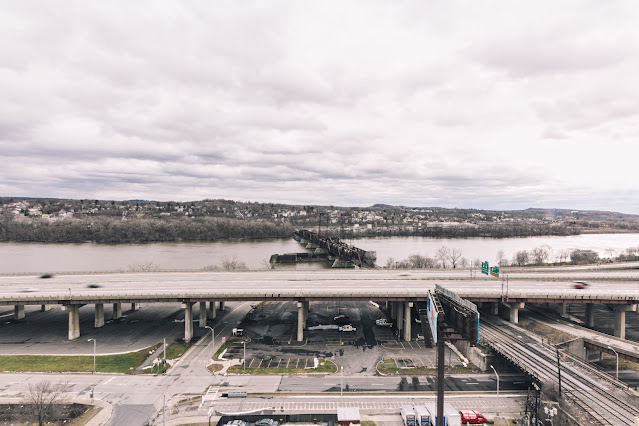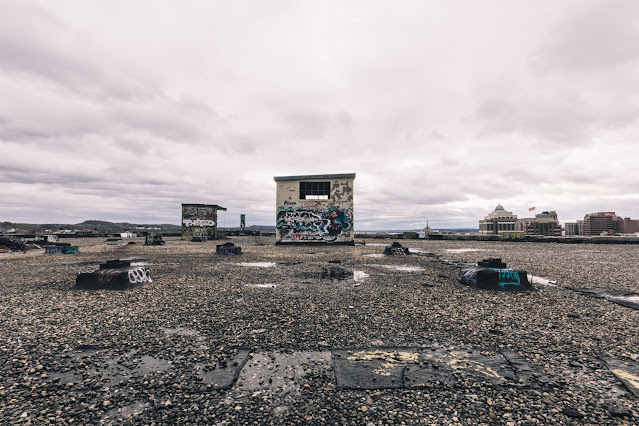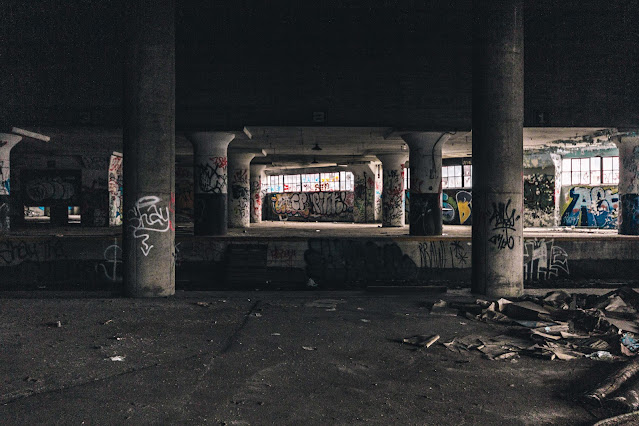Albany Central Warehouse Corporation aka The Cube
In the heart of Albany, nestled amidst the echoes of its bustling past, lies an abandoned warehouse, a treasure trove of stories untold until now. This isn't just any derelict structure; it's the cornerstone of my urban exploration journey, the first of many, but forever the one that initiated me into the world of forgotten spaces. Let's call it the ultimate introduction, the genesis of a passion that has since defined my adventures.
Our story begins on a crisp, cold morning that promises adventure. I vividly remember the excitement bubbling up as I set off to pick up my companion, referred to here as "A," from Queens. The journey from the familiar streets of our neighborhood to the unknown mysteries of Albany stretched over three hours, a pilgrimage to our very own urban Mecca.
We arrived ahead of schedule, anticipation building as we waited in the chilling embrace of dawn, our breaths visible in the air, our spirits undeterred. Our early morning venture led us to the local McDonald's, a pit stop for breakfast, while we awaited further instructions from our guide. However, what we encountered upon stepping inside was far removed from the vibrant, bustling atmosphere one might expect from the iconic fast-food chain. Instead, we found ourselves enveloped in a setting that seemed to defy the essence of what a place designed for quick, cheerful meals should embody.
The interior was draped in a palette of drab beige and brown, punctuated by floor tiles in a dissonant shade of red-brown that clashed with the overall aesthetic. Rather than inviting, this color scheme worked against the space, casting a gloom over the environment that was palpably out of place in a setting usually characterized by its bright and welcoming atmosphere. This visit predated the nationwide initiative by U.S. franchisees to infuse McDonald's locations with a more contemporary flair, featuring welcoming plush seating and modern lighting—a stark contrast to the dated and unwelcoming ambiance we found ourselves in.
The restroom further diminished our experience, presenting a stark testament to the establishment's neglect. It was immediately apparent that the space had become a refuge for local junkies, the air heavy with the acrid stench of burnt chemicals—a scent unsettlingly reminiscent of singed skin mingled with toxic fumes. This was not merely a restroom but a vivid illustration of the struggles and despair lurking behind the doors of even the most commonplace locations. Venturing into this McDonald's was an unwitting journey into a side of life that many travelers and tourists would be fortunate to never encounter.
The local connection, our guide into this unseen world, promised an unforgettable day. She was our Virgil in this urban inferno, leading us not into temptation but into revelation. Parking our cars, we approached the warehouse, a monument to times gone by, via a route that skirted an active rail line—a rail line that had once played a cameo in a feature film, the name of which eludes me now, lost to the annals of memory.
The warehouse's interior was our canvas, and we ascended immediately to the rooftop, drawn instinctively to the highest point for our first act of discovery. The rooftop was an unexpected oasis, its floor dotted with pools of water and smooth, river-worn stones scattered with an artist's carelessness. It was as if a celestial hand had attempted to create an urban pond, only forgetting to populate it with fish.
From this elevated vantage point, we captured the essence of Albany—the waterfront skyline, the bustling downtown, and the serene, if somewhat forlorn, rail line below. These were the first of many snapshots, not just of the city but of a moment in time, forever preserved.
Our exploration continued, drawn by gravity and curiosity, from the roof to the heart of the building, each floor revealing new secrets, each corner a narrative waiting to be uncovered. In its silent, stoic standing, this warehouse was more than just an abandoned structure; it was a portal to the past and a canvas for the future. This experience, our journey into the unknown, was a baptism of sorts—a rite of passage into the world of urban exploration. It taught us about the beauty in decay, the stories behind the silence, and the thrill of discovery. This Albany warehouse, with its waterlogged rooftop and its silent stories, was the beginning of an ongoing adventure that continues to shape this peculiar obsession.
Venturing further into the heart of this urban labyrinth, our exploration uncovered the warehouse's vast interior, a vertical expanse of about eleven floors. Each level above the first mirrored the architectural blueprint of early industrial might, characterized by row upon row of imposing pillars. This repetitive, cavernous environment, typical of factories from a bygone era, enveloped us in darkness, especially in areas far removed from the scant windows' grasp. The further we ventured, the more the light receded, leaving us to navigate a pitch-black void illuminated only by our flashlights and the occasional shaft of sunlight piercing through the gloom.
A constant hazard in our exploration was the presence of gaping freight elevator shafts. These dark, foreboding chasms beckoned unwary steps into a swift descent to the ground floor—a stark reminder of the dangers lurking within such forgotten spaces. Our guide's warnings echoed with each careful step, highlighting the blend of thrill and peril that defines urban exploration.
Amidst this shadowy expanse, the second floor unveiled a marvel as unexpected as it was extraordinary—a remnant of the building's storied past. Here, embedded within the floor, lay actual train line rails, cutting a path through the building from west to east. This architectural anomaly, a rare fusion of industrial utility and whimsical design, was a link to the warehouse's vibrant operational days. Such a feature is a rarity, a piece of history preserved in the unlikeliest places and unlikely to be replicated in modern constructions.
The warehouse's history was etched in its structure and the tales of its past use. It once played a crucial role in storing and distributing everyday supermarket items, connecting the mundane act of grocery shopping to this now-quiet giant. Among the whispered stories of its past, one particularly colorful anecdote stands out—a mysterious disappearance of 3,000 pounds of butter, a significant loss during a government relief effort. This incident, perhaps playfully attributed to the "Queen of Butter" herself, chef Paula Deen, in jest, adds a layer of intrigue and humor to the building's legacy.
Eight years prior, the Albany warehouse, a towering edifice of eleven stories, bore witness to a calamity that tested its foundations. In an event that would have spelled ruin for the less robust structures of our modern era, it endured a fire—a blaze that commenced on the tenth floor. The cause? An illicit endeavor to strip away pipework, an act that ignited more than just the flames. Yet, despite the inferno's ferocity, the warehouse stood resilient, a testament to the enduring strength of its construction. Composed of concrete, steel, and cork insulation—materials chosen for their capacity to house cold and dry storage operations—the building weathered the fire with a stoicism that belied its age. This structure remains upright and casts a shadow of reproach over contemporary building practices, hinting at a longevity that may very well mark its centennial, provided it escapes the hands of redevelopment or demolition in the forthcoming decade. Throughout its existence, this architectural behemoth has passed through many owners, each leaving their mark—or, notably, failing to do so, as the building has seen little change since 2017.
Nestled at the intersection of Colonie and Montgomery Streets stands the Central Warehouse Corporation, a testament to industrial prowess and architectural foresight. Incorporated in New York on July 23, 1985—or perhaps as far back as 1935, the records hint at a legacy that spans decades. Constructed in the mid-1920s, this behemoth of storage engineering utilized reinforced pillar-and-slab concrete, a hallmark of industrial design in the United States post-1910. Its steel-framed windows, characteristic of the era, gaze out onto the streets, witnesses to the passage of time.
The Central Warehouse was not just built but strategically integrated into the city's industrial fabric. A railroad spur, constructed at the same elevation as the New York Central Railroad bridge across the Hudson, allowed train cars direct entry into the warehouse at the second-story level. This feature, capable of accommodating approximately 22 train cars, underscored the building's pivotal role in the logistical networks of the time. This unique railway connection brought goods straight to the heart of the storage facility.
Opening its doors in 1927 as a cold and dry storage facility, the Central Warehouse emerged before the norm of retailers and distributors maintaining such spaces. Spanning 400,000 square feet, this colossus once safeguarded enough frozen foods to nourish the Capital District several times. Yet, despite its capacity and critical function, it has stood vacant since at least 1990, a silent sentinel over a bygone era of commerce and industry.
The range of commodities that passed through its doors was vast, encompassing general merchandise, foodstuffs, dairy products, meats, and other perishables. Its cold storage facilities, equipped with ammonia direct expansion systems, maintained temperatures ranging from 9 to 36 degrees Fahrenheit, offering over 2.7 million cubic feet of refrigerated space. The warehouse's versatility was such that it even served as a secure haven for fur coats and wraps, as highlighted in an article titled “New Trade at Cold Terminal,” a nod to the personalized services it offered beyond mere food storage.
The Central Warehouse stands as a monument to industrial innovation and the complexities of supply chain logistics in the early 20th century. Its construction and operation reflect a time when such facilities were central to the economic vitality of regions, serving as crucial nodes in a broader network of production, storage, and distribution. Today, it remains a formidable presence, a reminder of the ingenuity and ambition that characterized the era of its inception.
 |
| My friend 'A' photo bombing my window shot. |
The narrative of the Central Warehouse is as storied as its physical presence is imposing, marked by a series of events that underscore its controversial and complex history since the 1980s. At the heart of one of its most notable chapters was Richard Gerrity, a businessman and philanthropist whose actions left an indelible mark on the building's facade and legacy. Driven by deep religious conviction, Gerrity emblazoned the warehouse with a massive “Year of the Bible” sign in 1983. This bold declaration was a statement of faith and a catalyst for legal and regulatory controversy. It drew the ire of the New York State Department of Transportation (DOT), sparking a debate over the sign's legality under the federal Highway Beautification Act. The DOT's contention was apparent: the sign's dimensions made it an infringement, a battle culminating in an out-of-court agreement that saw the sign's removal in 1987.
The saga of the Central Warehouse continued as C.W. Associates, led by Gerrity, declared bankruptcy in 1995, turning a new page in the building's history. The property's next chapter began when Trustco Bank acquired it at a foreclosure auction in 1996, setting the stage for another transition. In 1997, Frank Crisafulli, a retired food distribution company owner, purchased the warehouse for the symbolic sum of $1 and assumed $120,000 in back taxes—a testament to the building's perceived liability and potential.
Crisafulli's tenure was brief but significant, selling the property in 2002 to Albany Assets for $800,000, underscoring the warehouse's fluctuating value and the speculative interest it generated. The building's journey through ownership and visions for its future continued; in 2007, it changed hands again and sold for $1.4 million to CW Montgomery LLC. This entity harbored redevelopment ambitions, envisioning a warehouse transformation into a mixed-use project. This vision speaks to the ongoing narrative of urban renewal and the reimagining of industrial spaces in contemporary cities. Through ownership cycles, legal battles, and evolving visions for its future, the Central Warehouse remains a focal point of intrigue and potential in Albany's urban landscape.
Evan Blum's tenure as the owner of the Central Warehouse is a testament to the complexities and challenges of stewarding a piece of industrial history. His relationship with the city of Albany was fraught with contention, highlighting the tug-of-war between preservation efforts and urban safety concerns. The crux of their disputes often centered around the state of the building and its compliance with city-imposed regulations.
In a particularly telling episode of this ongoing saga, the city mandated in August 2022 that Blum weather-seal all entrances and windows of the warehouse, a directive aimed at mitigating further decay and preventing the elements from hastening its deterioration. However, this deadline came and went without action from Blum, marking a significant point of contention between the owner and municipal authorities. This failure to comply underscored the challenges of maintaining such a colossal, aging structure within the confines of modern regulatory expectations.
The stakes of this strained relationship were dramatically highlighted in July 2022 when parts of the building's facade began to crumble, a stark reminder of its fragility. Debris, a critical transportation artery, fell below the Amtrak railroad tracks, prompting Amtrak to suspend service. This incident not only underscored the potential dangers posed by the neglected state of the warehouse but also the broader implications for public safety and infrastructure. The city of Albany was compelled to intervene, shouldering the cost of emergency repairs to $225,000 to ensure the resumption of train services.
In a dramatic turn of events that underscores the cyclical saga of Albany's Central Warehouse, Albany County took control of the property from Evan Blum, the longtime owner, through a lien foreclosure due to $500,000 in back taxes owed to the city. This shift in ownership marks the latest chapter in the building's history, opening the door to new possibilities for redevelopment and repurposing.
In the latter part of 2022, ambitious plans emerged from two development companies aiming to breathe new life into the warehouse. Their vision was to transform the second to fourth floors into 100 market-rate apartments while dedicating the ground floor to 25,000 square feet of commercial and retail space. This proposed $100 million investment in the warehouse district, with an anticipated $30 million in public funding, signaled a hopeful future for a building that has, for years, stood as a challenging emblem of urban decay and lost potential.
Despite the warehouse's revolving door of ownership and the array of development proposals that have come and gone, actual progress still needs to be made. The property, built in 1927, has presented a daunting challenge to developers, attributed to the "astronomical costs" of redevelopment. Compounding these financial hurdles are the constraints of rising prices, shifting zoning regulations within the capital city, and the building's deteriorated condition, which has complicated efforts to secure historic tax credits.
The most recent development narrative hinted at a radical solution: demolishing the warehouse and returning the land to the county. This consideration reflects the profound difficulties in reconciling the vision for urban renewal with the pragmatic realities of restoring a nearly century-old structure. While pragmatic from a developmental standpoint, the prospect of demolition carries the weight of historical loss and the erasure of a significant architectural landmark.
Albany residents may feel a sense of déjà vu due to the recurrent cycles of proposed development and stagnation. The latest attempt by consortiums, including Redburn Development and Columbia Development, to renovate the warehouse ended in familiar disappointment, with no tangible outcomes. Over the years, the building's physical state has visibly deteriorated, necessitating the application of netting to secure falling concrete from its façade, a stark reminder of the warehouse's precarious condition.
 |
| The Amtrak Broadway Bridge is centered over the Hudson River. The tracks that debris fell onto run right next to the building. |
The final chapter in the saga of Albany's Central Warehouse appears to be drawing to a close, with the decision by CW Skyway to proceed with the building's demolition. This decision marks a poignant moment in the city's history, acknowledging the complex legacy of a structure that, despite being labeled an "eyesore" by many, holds a unique place in the narrative of Albany's 20th-century industrial and commercial heritage.
The Central Warehouse, once a vital node in the network of shipping and food distribution, stands as a testament to Albany's role as a crucial crossroads. The impending demolition, driven by local representatives and politicians' calls for action, reflects a broader desire to move past the building's dilapidated state, which has long been considered a blight on the landscape. The pursuit of grant financing from the state to cover demolition costs underscores the community's commitment to reclaiming and repurposing this site, with Redburn Development estimating the demolition to cost around $10 million.
The Central Warehouse's unique architectural and historical attributes, including its refrigerated walls designed for cold storage and the railroad inlet that facilitated direct access for shipping, highlight its significance beyond mere functionality. These features, along with the vibrant graffiti adorning its interior, captured in the "Abandoned 'Supermarket' Warehouse" post, remind the building's storied past and the layers of history embedded within its walls.
As the community stands on the brink of this transformative demolition, it is essential to consider what will be lost alongside what may be gained. The erasure of the Central Warehouse from Albany's skyline will undoubtedly alter the city's physical and cultural landscape. Yet, it also opens up possibilities for new development and the reimagining of urban space. The challenge lies in ensuring that whatever rises in its place honors the rich tapestry of Albany's history while addressing the needs and aspirations of its current and future residents.
The story of the Central Warehouse is a microcosm of the broader challenges facing post-industrial cities across the nation, grappling with the legacies of their industrial pasts while striving towards revitalization and renewal. As Albany navigates this transition, the demolition of the Central Warehouse serves as a catalyst for reflection on the value of preservation, the inevitability of change, and the continuous evolution of urban landscapes.
Sources:
1. U.S. Government Printing Office. (1955). The Port of Albany, New York. [URL]
2. U.S. Government Printing Office. (1965). The Port of Albany, New York: Part 2. [URL]
3. Mount Ida Press. (1993). Albany Architecture: A Guide to the City. [URL]
4. Moody's Investors Service. (1950). Moody's Industrial Manual. [URL]
5. Singleton, M. (2022, October 27). Evan Blum finally loses Central Warehouse but legal troubles still loom. News10.
6. Cropley, J. (2022, August 1). Central Warehouse fixes allow Amtrak to resume service through Albany. The Daily Gazette.
7. Armstrong, S. (1986, November 12). 'Year of the Bible' Ending State Persuades Firm to Cover 1983 Sign. Times Union (Albany). Hearst Communications. p. B1.
8. Central Warehouse. AllOverAlbany
9. Stanley, Abbi, "Albany Central Warehouse to be demolished," January 24, 2024, News10 ABC
10. McNeil, Tyler, "Albany's Central Warehouse to be demolished," January 30, 2024, The Daily Gazette
11. Johnson, David, "Albany’s Central Warehouse: From icon to eyesore," February 1, 2024, Times Union













Comments
Post a Comment